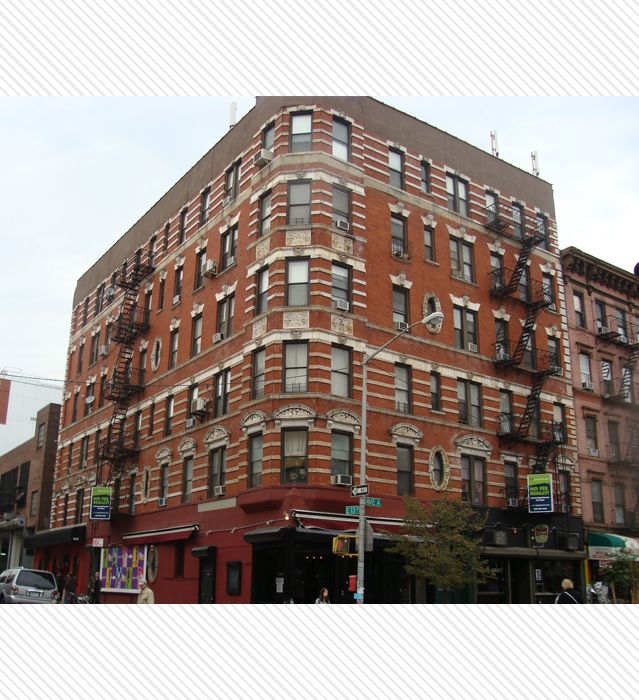Description & Building Alterations
This six-story brick tenement was designed by George Frederick Pelham, originally built in 1903 for stores and 35 families. The building shares similar facade elements with many other tenements designed by the architect. The present facade features original splayed window lintels with ornamented keystones, decorated beltcourses, oval window openings with elaborate surrounds, segmental-arched pediments with elaborately decorated tympanums at the second story, engaged pilasters flanking the main entry on the east facade, and an oval opening with a rhombus window at the first story of the south facade. The historic roof cornice was removed prior to the 1980s, when the tax photo was taken.
In the early 20th century East 13th Street between 1st Avenue and Avenue A was a center of Sicilian religious custom and ritual that, while ostensibly Catholic, operated outside the sanction of the formal Catholic Church. The street had a series of private “storefront chapels” that venerated religious figures rooted in the old country, including the chapel of the Black Madonna at 447 East 13th Street.
Located in a small space in the ground floor of a tenement and next to Rotella’s funeral parlor, the chapel housed a stucco statue of the Black Madonna of Tindari (a city in Sicily), which was credited by believers with possessing curative powers. The Black Madonna tradition extends back to at least the middle ages, and veneration of the statue, which stood in the window, took place each year starting in 1909 on a feast day on September 8th. The tradition continued until 1987 when the chapel closed and the statue was given to a family in New Jersey.
Appropriately enough, as of 2019 the space had been occupied for two decades by a gay bar known as ‘The Phoenix,’ where Madonna can be heard playing from time to time. A group of Italian-American scholars, artists, and friends have held a reunion of sorts each year in early September in the space to mark the day of the feast.
The building is also the site of significant East Village mafia history. On October 28, 1928, Salvatore “Toto” D’Aquila, once the country’s most powerful mafia boss and leader of what would later become the Gambino mafia family, was shot and killed in front of 211 Avenue A, where he had just dropped off his wife and children for a doctor’s appointment. His title was then yielded to Joseph Masseria, who lived at 80 Second Avenue. Decades later, Jerry’s Lounge was located at 211 Avenue A in 1971. The bar was frequented by Vincent Rizzo, a member of the Genovese mafia family known for loan-sharking, as well as stealing and counterfeiting one billion dollars. Here, detectives monitored and recorded Rizzo and other mafia members’ conversations, uncovering their association with the Vatican.
More +Close -


Do you know this building? Please share your own stories or photos of this building here!